Kanagawa and more
- Sort by
- Popularity
- Name
-
Kutani ware Kutani yaki
- Ceramic
- Ishikawa

Kutani ware (called Kutani yaki in Japanese) is a type of pottery manufactured in and around the city of Kaga in Ishikawa prefecture. It is a traditional handicraft that was first produced during the early Edo period (beginning of the 17th century…
View more
-
Wajima lacquerware Wajima nuri
- Lacquerware
- Ishikawa
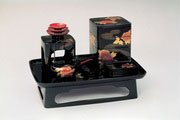
Wajima lacquerware (called Wajima nuri in Japanese) is made in the city of Wajima, Ishikawa prefecture. The most notable features of Wajima lacquerware are not only its beautiful finish but also the high quality powder used for its production call…
View more
-
Koishiwara ware Koishiwara yaki
- Ceramic
- Fukuoka

Koishiwara ware (called Koishiwara yaki in Japanese) is a form of pottery produced in the Asakura district of Fukuoka prefecture. Since its creation, Koishiwara ware has evolved to become a practical, beautiful pottery. Koishiwara ware's uniq…
View more
-
Kaga textiles Kaga yuzen
- Dyed textiles
- Ishikawa
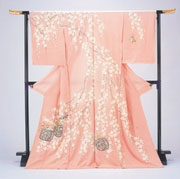
Kaga textiles (called Kaga yuzen in Japanese) are kimonos produced around the city of Kanazawa, Ishikawa prefecture. This craft is noteworthy because of its use of five underlying tones: indigo, khaki, green, dark reddish purple, and deep red. Kyo…
View more
-
Mino ware Mino yaki
- Ceramic
- Gifu
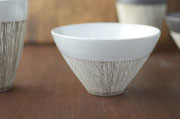
Mino ware (called Mino yaki in Japanese) is a ceramic ware produced in the Tono area of Gifu prefecture. It has a long history and tradition but has adapted to modern life style. A notable feature of Mino ware is its wide variety of pottery. Mino …
View more
-
Nishijin brocade Nishijin ori
- Woven textiles
- Kyoto
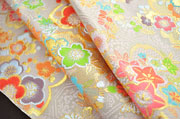
Nishijin brocade (called Nishijin ori in Japanese) is woven silk produced in the northwestern part of Kyoto. Kamigyo ward and Kita ward cover this area of Kyoto today, but this area is called Nishijin. According to official rules, only the brocade…
View more
-
Hakata doll Hakata ningyo
- Dolls, kokeshi
- Fukuoka
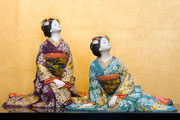
Hakata dolls (called Hakata ningyo in Japanese) are unglazed clay dolls produced in the city of Hakata, in Fukuoka prefecture. The notable features of Hakata dolls are their subtle soft colors, delicately carved expressions, and curves that almost…
View more
-
Kamakura-bori lacquerware Kamakura bori
- Lacquerware
- Kanagawa
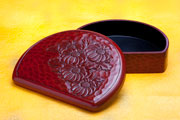
Kamakura-bori is a type of lacquer ware made in the area around the city of Kamakura in Kanagawa prefecture. The tradition dates back to the Kamakura period (1185-1333) when Tsuishu and Tsuikoku, thickly lacquered wooden wares, were imported from …
View more
-
Hakone wood mosaic Hakone yosegi zaiku
- Wood, bamboo crafts
- Kanagawa
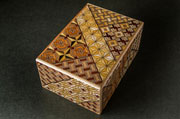
Hakone yosegi zaiku is a form of marquetry produced in the town of Hakone, Kanagawa prefecture, an area renowned for having the most natural environment in Japan. For this reason, there is a rich variety of tree species found on Mt. Hakone. Such a…
View more
-
Kurume traditional resist-dyed textiles Kurume gasuri
- Woven textiles
- Fukuoka
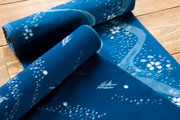
Kurume traditional resist-dyed textiles (Kurume gasuri in Japanese) is a woven cloth produced in and around the city of Kurume, Fukuoka prefecture. The breathability assures coolness in the summer and excellent heat-retaining properties provide wa…
View more
-
Kyo textiles Kyo yuzen
- Dyed textiles
- Kyoto

Kyo textiles are dyed textiles made throughout Kyoto prefecture that feature a wide range of vivid colors and a technique of pictorial designs of animals, nature and daily items called yuzenmoyo. The dyeing method is very unique as artisans put gl…
View more
-
Hakata brocade Hakata ori
- Woven textiles
- Fukuoka
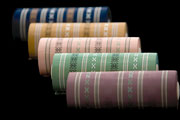
Hakata ori refers to the ori or woven cloth produced in and around Hakata, Fukuoka prefecture. Hakata weaving techniques, which originated in China, have shaped this unique cloth. It has been highly regarded for its high quality throughout the age…
View more
-
Mino traditional Japanese paper Mino washi
- Traditional Japanese paper
- Gifu
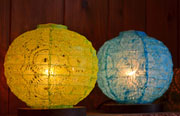
Mino washi is a type of Japanese paper made in Gifu prefecture. Washi is made from paper mulberry which is a plant that grows in the city of Mino, a place of abundant forests. Ancient manuscripts in the Shosoin Repository* indicate the history of …
View more
-
Kyo folding fans Kyo sensu
- Other crafts
- Kyoto
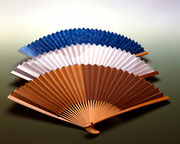
Kyo folding fans (called Kyo sensu in Japanese with sensu meaning folding fan) are mainly produced in Kyoto. From ancient times they have been valued as high quality art works because of their beautiful designs with gold or silver leaves or gold l…
View more
-
Ushikubi tsumugi silk Ushikubi tsumugi
- Woven textiles
- Ishikawa
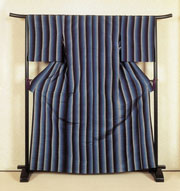
Ushikubi tsumugi is a silk textile produced in the city of Hakusan, Ishikawa prefecture. It was recognized as a traditional craft in 1988. Some distinctive features of Ushikubi (which literally translates to cow's neck) tsumugi silk are its m…
View more
-
Yamanaka lacquerware Yamanaka shikki
- Lacquerware
- Ishikawa
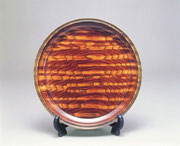
Yamanaka lacquerware (called Yamanaka shikki in Japanese) is a type of lacquerware made in the Yamanaka Onsen (hot spring) district of the city of Kaga, Ishikawa prefecture. It utilizes an original Yamanaka technique for grinding wood. The main ob…
View more
-
Agano ware Agano yaki
- Ceramic
- Fukuoka
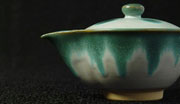
Agano ware (called Agano yaki) is a form of pottery produced around the town of Fukuchi in Fukuoka prefecture. Agano ware is elegant and lightweight, stemming from its development as a tea bowl for use in tea ceremonies. In some cases, the foot o…
View more
-
Kiso lacquerware Kiso shikki
- Lacquerware
- Nagano
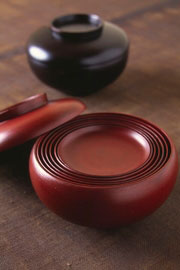
Kiso lacquerware (called Kiso shikki in Japanese) is produced in Kiso district, now the city of Shiojiri, Nagano prefecture. The area where this craft is produced is a plateau approximately 900 meters above sea level. The climate has cool summers…
View more
-
Matsumoto furniture Matsumoto kagu
- Wood, bamboo crafts
- Nagano

Matsumoto kagu is a type of Japanese traditional furniture made in the city of Matsumoto in Nagano prefecture and has been produced for over three hundred years, since the Edo period (1603-1868). The Second World War led production of this craft t…
View more
-
Gifu lanterns Gifu chochin
- Other crafts
- Gifu
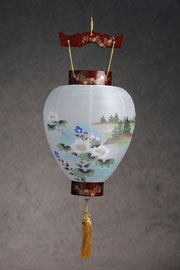
Gifu lanterns (called Gifu chochin in Japanese) are produced in the city of Gifu, Gifu prefecture and have a history of over three hundred years. In 1995, their high level of craftsmanship was recognized with a designation as a National Traditiona…
View more
-
Kyo doll Kyo ningyo
- Dolls, kokeshi
- Kyoto
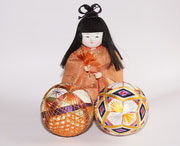
Kyo dolls (called Kyo ningyo in Japanese) are produced in the city of Kyoto and its surrounding areas in Kyoto prefecture. They are made by several different artisans with their specialized expertise. There are doll head artisans as well as those …
View more
-
Ichii woodcarvings Ichii itto bori
- Wood, bamboo crafts
- Gifu
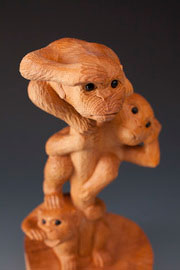
Ichii woodcarvings (called Ichii itto bori in Japanese) are produced in the Hida region of Gifu prefecture, and made only from the wood of ichii (Japanese yew), the prefectural tree of Gifu. The ichii tree gets its name from a scepter made of Japa…
View more
-
Kyo uchiwa fans Kyo uchiwa
- Other crafts
- Kyoto
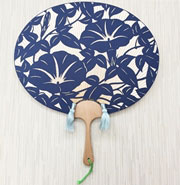
Kyo uchiwa are a type of fan made in Kyoto prefecture. From the many types of Japanese traditional fans, there are three broad categories: Chinese-inspired, southern-inspired, and Korean-inspired with this craft coming from the third category. Th…
View more
-
Hida-shunkei lacquerware Hida shunkei
- Lacquerware
- Gifu
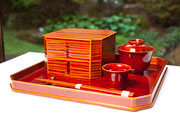
Hida-shunkei lacquerware is produced around the city of Takayama in Gifu prefecture. The name is said to come from the fact that the articles produced initially had a similar coloring to Hishunkei tea containers. This craft is notable for having …
View more
-
Kanazawa gold leaf Kanazawa haku
- Industrial art materials and tools
- Ishikawa
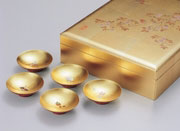
The word haku means metal leaf and Kanazawa haku is gold leaf produced in and around the city of Kanazawa, Ishikawa prefecture. This craft possesses the dazzling and elegant radiance of gold even after being worked on by craftsmen. A small piece o…
View more
-
Kanazawa lacquerware Kanazawa shikki
- Lacquerware
- Ishikawa
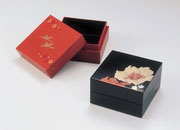
Kanazawa lacquerware (called Kanazawa shikki in Japanese) is produced in the area around the city of Kanazawa, in Ishikawa prefecture. It was developed for the liking of feudal lords as it had the financial backing of the Kaga domain (present day …
View more
-
Kyo ware/Kiyomizu ware Kyo yaki Kiyomizu yaki
- Ceramic
- Kyoto
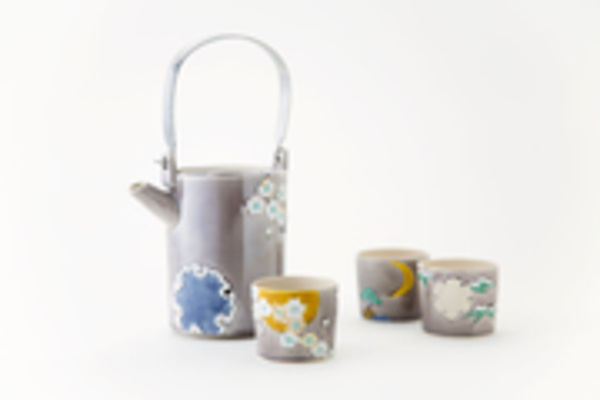
Kyo-ware/Kiyomizu-ware (called Kyo yaki/Kiyomizu yaki in Japanese) is a type of pottery produced in the Kyoto area. Originally, Kyo-ware was a general term for all pottery produced in Kyoto, while Kiyomizu-ware specifically referred to pottery pro…
View more
-
Kyo laquerware Kyo shikki
- Lacquerware
- Kyoto
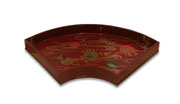
Kyo lacquerware (called Kyo shikki in Japanese) is produced in the Kyoto area. Since it developed at the same time as the tea ceremony culture, this craft possesses a wabi-sabi* quality. Kyo lacquerware has a thinner and more delicate wood grain t…
View more
-
Odawara lacquerware Odawara shikki
- Lacquerware
- Kanagawa
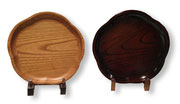
Odawara lacquerware (called Odawara shikki in Japanese) is a type of lacquerware that is made in the city of Odawara, Kanagawa prefecture. It features a glossy lacquer finish which highlights the elegant grain of the wood material. While beautiful…
View more
-
Kyo braided cords Kyo kumihimo
- Other textiles
- Kyoto
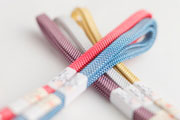
Kyo Braided Cords (called Kyo Kumihimo in Japanese) are produced around the cities of Kyoto and Uji, Kyoto prefecture. Since the Heian period (794-1192), this craft has been found on prestigious and sacred pieces such as Buddhist and Shinto altar …
View more

































































































































































































































































































